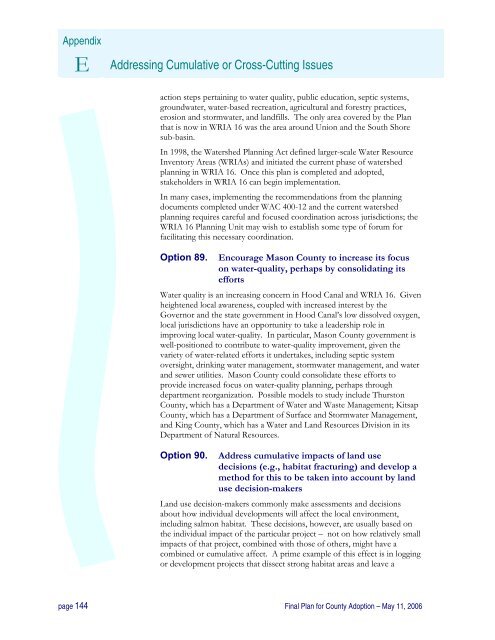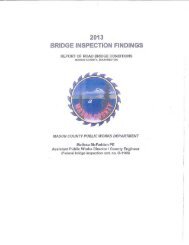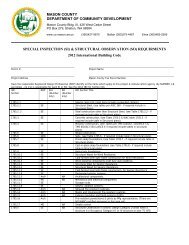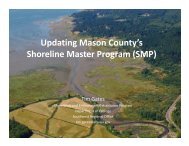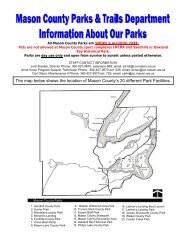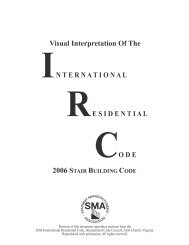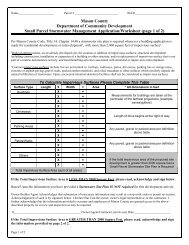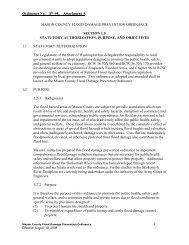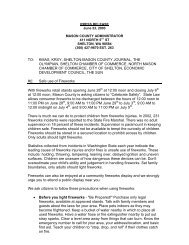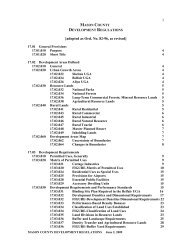Watershed Management Plan - Mason County
Watershed Management Plan - Mason County
Watershed Management Plan - Mason County
You also want an ePaper? Increase the reach of your titles
YUMPU automatically turns print PDFs into web optimized ePapers that Google loves.
Appendix<br />
E Addressing Cumulative or Cross-Cutting Issues<br />
action steps pertaining to water quality, public education, septic systems,<br />
groundwater, water-based recreation, agricultural and forestry practices,<br />
erosion and stormwater, and landfills. The only area covered by the <strong>Plan</strong><br />
that is now in WRIA 16 was the area around Union and the South Shore<br />
sub-basin.<br />
In 1998, the <strong>Watershed</strong> <strong>Plan</strong>ning Act defined larger-scale Water Resource<br />
Inventory Areas (WRIAs) and initiated the current phase of watershed<br />
planning in WRIA 16. Once this plan is completed and adopted,<br />
stakeholders in WRIA 16 can begin implementation.<br />
In many cases, implementing the recommendations from the planning<br />
documents completed under WAC 400-12 and the current watershed<br />
planning requires careful and focused coordination across jurisdictions; the<br />
WRIA 16 <strong>Plan</strong>ning Unit may wish to establish some type of forum for<br />
facilitating this necessary coordination.<br />
Option 89.<br />
Encourage <strong>Mason</strong> <strong>County</strong> to increase its focus<br />
on water-quality, perhaps by consolidating its<br />
efforts<br />
Water quality is an increasing concern in Hood Canal and WRIA 16. Given<br />
heightened local awareness, coupled with increased interest by the<br />
Governor and the state government in Hood Canal’s low dissolved oxygen,<br />
local jurisdictions have an opportunity to take a leadership role in<br />
improving local water-quality. In particular, <strong>Mason</strong> <strong>County</strong> government is<br />
well-positioned to contribute to water-quality improvement, given the<br />
variety of water-related efforts it undertakes, including septic system<br />
oversight, drinking water management, stormwater management, and water<br />
and sewer utilities. <strong>Mason</strong> <strong>County</strong> could consolidate these efforts to<br />
provide increased focus on water-quality planning, perhaps through<br />
department reorganization. Possible models to study include Thurston<br />
<strong>County</strong>, which has a Department of Water and Waste <strong>Management</strong>; Kitsap<br />
<strong>County</strong>, which has a Department of Surface and Stormwater <strong>Management</strong>,<br />
and King <strong>County</strong>, which has a Water and Land Resources Division in its<br />
Department of Natural Resources.<br />
Option 90.<br />
Address cumulative impacts of land use<br />
decisions (e.g., habitat fracturing) and develop a<br />
method for this to be taken into account by land<br />
use decision-makers<br />
Land use decision-makers commonly make assessments and decisions<br />
about how individual developments will affect the local environment,<br />
including salmon habitat. These decisions, however, are usually based on<br />
the individual impact of the particular project – not on how relatively small<br />
impacts of that project, combined with those of others, might have a<br />
combined or cumulative affect. A prime example of this effect is in logging<br />
or development projects that dissect strong habitat areas and leave a<br />
page 144 Final <strong>Plan</strong> for <strong>County</strong> Adoption – May 11, 2006


